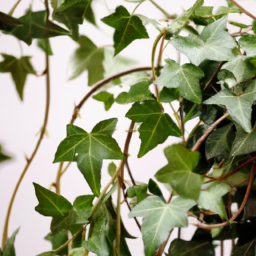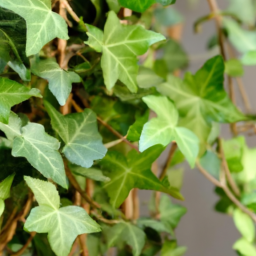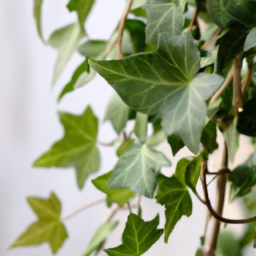
Are you looking to add some greenery to your indoor space? Ivy houseplant types are a great option to consider! With their beautiful trailing vines and lush foliage, ivy plants can add a touch of elegance and charm to any room. In this blog post, we will explore the different types of ivy houseplants available, their unique characteristics, and how to care for them to ensure they thrive in your home. Whether you’re a seasoned plant parent or a beginner looking to start your indoor garden, ivy houseplants are a versatile and low-maintenance option that can bring life and beauty to your living space.
Popular Ivy Houseplant Varieties
English Ivy
English Ivy is one of the most popular ivy houseplant varieties due to its easy care and elegant appearance. This ivy features dark green, glossy leaves that can grow in a variety of shapes and sizes, making it a versatile addition to any indoor space. English Ivy is known for its ability to trail or climb, making it a great choice for hanging baskets or as a decorative accent on shelves or mantels.
One of the key benefits of English Ivy is its air-purifying properties, as it can help remove toxins from the air and improve indoor air quality. This ivy thrives in bright, indirect light and prefers to be kept slightly moist but not waterlogged. It is important to avoid overwatering English Ivy, as this can lead to root rot and other issues.
English Ivy is a great choice for beginner plant enthusiasts, as it is relatively low maintenance and can adapt to a variety of indoor environments. With proper care, this ivy can thrive for many years and add a touch of greenery to any room.
Devil’s Ivy
Devil’s Ivy, also known as Pothos or Golden Pothos, is another popular ivy houseplant variety that is beloved for its vibrant green leaves and easy care requirements. This ivy features heart-shaped leaves with splashes of yellow or white variegation, adding a pop of color to any indoor space. Devil’s Ivy is a fast-growing plant that can trail or climb, making it a great choice for hanging baskets or as a decorative accent on shelves or mantels.
One of the key benefits of Devil’s Ivy is its ability to thrive in low light conditions, making it a great choice for offices or rooms with limited natural light. This ivy is also known for its air-purifying properties, as it can help remove toxins from the air and improve indoor air quality. Devil’s Ivy prefers to be kept slightly moist but not waterlogged, and it is important to avoid overwatering to prevent root rot.
Devil’s Ivy is a great choice for beginner plant enthusiasts, as it is low maintenance and can adapt to a variety of indoor environments. With proper care, this ivy can thrive for many years and bring a touch of nature indoors.
Algerian Ivy
Algerian Ivy is a unique ivy houseplant variety that is prized for its large, leathery leaves and striking variegation. This ivy features dark green leaves with creamy white or yellow edges, creating a bold and eye-catching appearance. Algerian Ivy is a fast-growing plant that can trail or climb, making it a great choice for hanging baskets or as a decorative accent on shelves or mantels.
One of the key benefits of Algerian Ivy is its ability to thrive in a variety of light conditions, from bright indirect light to partial shade. This ivy prefers to be kept slightly moist but not waterlogged, and it is important to avoid overwatering to prevent root rot. Algerian Ivy is a great choice for plant enthusiasts looking to add a touch of drama to their indoor space.
Algerian Ivy is a relatively low maintenance plant that can adapt to a variety of indoor environments. With proper care, this ivy can thrive for many years and add a touch of elegance to any room.

Care Tips for Different Types of Ivy Houseplants
English Ivy
English Ivy, also known as Hedera helix, is a popular choice for indoor houseplants due to its elegant and cascading foliage. To care for your English Ivy, place it in a location with bright, indirect sunlight. Water the plant regularly, keeping the soil moist but not waterlogged. Ivy plants prefer high humidity, so misting the leaves occasionally can help keep them healthy.
Pruning is important for English Ivy to maintain its shape and encourage new growth. You can trim back any leggy or overgrown vines to promote a bushier appearance. Fertilize your English Ivy every few months with a balanced houseplant fertilizer to keep it thriving.
Pests such as spider mites and aphids can be a problem for English Ivy, so keep an eye out for any signs of infestation. You can use insecticidal soap to treat these pests if necessary. Overall, English Ivy is a low-maintenance plant that can add a touch of greenery to any indoor space.
Devil’s Ivy
Devil’s Ivy, also known as Golden Pothos or Epipremnum aureum, is a versatile and easy-to-care-for houseplant. This ivy variety thrives in low light conditions, making it a great choice for offices or rooms with limited sunlight. Water your Devil’s Ivy when the top inch of soil is dry, and be sure to drain any excess water to prevent root rot.
Regular pruning can help Devil’s Ivy maintain its compact shape and encourage new growth. You can trim back any yellow or leggy vines to keep the plant looking healthy and vibrant. Fertilize your Devil’s Ivy every few months with a balanced liquid fertilizer to provide essential nutrients.
Devil’s Ivy is relatively pest-resistant, but mealybugs and scale insects can sometimes be a problem. Inspect your plant regularly for any signs of infestation, and treat with neem oil or insecticidal soap as needed. With proper care, Devil’s Ivy can thrive and brighten up any indoor space.
Algerian Ivy
Algerian Ivy, also known as Hedera canariensis, is a fast-growing and hardy ivy variety that can be grown both indoors and outdoors. This ivy plant prefers bright, indirect sunlight and well-draining soil. Water your Algerian Ivy regularly, allowing the top inch of soil to dry out between waterings.
Pruning is essential for Algerian Ivy to prevent it from becoming too leggy or invasive. You can trim back any overgrown vines or yellow leaves to maintain the plant’s shape and health. Fertilize your Algerian Ivy every few months with a balanced liquid fertilizer to promote growth and green foliage.
Algerian Ivy is generally pest-resistant, but spider mites and aphids can sometimes be a problem. Keep an eye out for any signs of infestation, and treat with insecticidal soap or neem oil if necessary. With proper care, Algerian Ivy can thrive and add a touch of elegance to your indoor or outdoor space.
In conclusion, caring for different types of ivy houseplants involves providing the right amount of light, water, and nutrients, as well as keeping an eye out for pests. By following these care tips, you can enjoy healthy and vibrant ivy plants in your home or garden.

Unique and Rare Ivy Houseplant Species
English Ivy (Hedera helix)
English Ivy, also known as Hedera helix, is a classic and popular ivy houseplant that is loved for its elegant trailing vines and lush green leaves. This ivy species is versatile and can be grown in hanging baskets, as a ground cover, or trained to climb up a trellis. English Ivy is relatively easy to care for, making it a great choice for beginner gardeners.
One of the unique features of English Ivy is its ability to purify the air by removing toxins such as formaldehyde and benzene. This makes it a great choice for indoor spaces where air quality may be a concern. English Ivy prefers bright, indirect light and regular watering to keep its soil moist but not waterlogged. It is important to avoid overwatering, as this can lead to root rot.
Propagation of English Ivy is relatively easy, as it can be propagated from stem cuttings placed in water or soil. Pruning is also important to keep English Ivy looking tidy and to encourage new growth. Overall, English Ivy is a beautiful and versatile ivy houseplant that is sure to add a touch of elegance to any indoor space.
Variegated Algerian Ivy (Hedera algeriensis ‘Gloire de Marengo’)
Variegated Algerian Ivy, also known as Hedera algeriensis ‘Gloire de Marengo’, is a stunning and rare ivy houseplant that features striking variegated leaves with shades of green, white, and cream. This ivy species is a showstopper and is sure to be a conversation piece in any indoor garden. Variegated Algerian Ivy is a fast-growing ivy that can quickly cover a trellis or wall with its beautiful foliage.
One of the unique characteristics of Variegated Algerian Ivy is its ability to thrive in low light conditions, making it a great choice for indoor spaces with limited sunlight. However, it is important to avoid direct sunlight, as this can cause the variegated leaves to burn. Variegated Algerian Ivy prefers to be kept in a humid environment, so regular misting or placing a humidity tray nearby can help to keep this ivy species happy and healthy.
Propagation of Variegated Algerian Ivy can be done through stem cuttings placed in water or soil. Pruning is also important to maintain the shape and size of this ivy species. Overall, Variegated Algerian Ivy is a rare and beautiful ivy houseplant that is sure to be a standout in any indoor garden.
Needlepoint Ivy (Hedera helix ‘Needlepoint’)
Needlepoint Ivy, also known as Hedera helix ‘Needlepoint’, is a unique and rare ivy houseplant that features delicate, needle-like leaves that give it a distinct appearance. This ivy species is prized for its fine texture and elegant look, making it a popular choice for adding a touch of sophistication to any indoor space. Needlepoint Ivy is a slow-growing ivy that is perfect for small containers or terrariums.
One of the unique qualities of Needlepoint Ivy is its ability to thrive in a wide range of light conditions, from bright indirect light to low light. This makes it a versatile choice for indoor spaces with varying light levels. Needlepoint Ivy prefers to be kept in well-draining soil and watered when the top inch of soil feels dry. It is important to avoid overwatering, as this can lead to root rot.
Propagation of Needlepoint Ivy can be done through stem cuttings placed in water or soil. Pruning is also important to maintain the shape and size of this ivy species. Overall, Needlepoint Ivy is a rare and elegant ivy houseplant that is sure to add a touch of sophistication to any indoor garden.
In Summary
If you’re looking to add some greenery to your home, ivy houseplants are a great option to consider. There are several different types of ivy plants that vary in size, shape, and color, making them a versatile choice for any space. Some popular varieties include English Ivy, Algerian Ivy, and Swedish Ivy, each with its own unique characteristics.
English Ivy is known for its classic, elegant look with deep green leaves that cascade beautifully down a hanging basket or trellis. Algerian Ivy, on the other hand, has larger, glossy leaves that add a touch of drama to any room. Swedish Ivy is a compact plant with small, rounded leaves that are perfect for adding a pop of green to a shelf or tabletop. No matter which type of ivy plant you choose, they are relatively easy to care for and can thrive in a variety of lighting conditions, making them a low-maintenance option for beginner plant enthusiasts. So why not bring a touch of nature indoors with a beautiful ivy houseplant today?
Common Questions and Answers:
Q1: What are some common types of ivy houseplants?
A1: Some common types of ivy houseplants include English Ivy, Swedish Ivy, Algerian Ivy, and Devil’s Ivy. Each type has its own unique characteristics and care requirements.
Q2: Which ivy houseplant is best for beginners?
A2: Devil’s Ivy, also known as Pothos, is a great choice for beginners as it is easy to care for and can thrive in various lighting conditions. It is known for its trailing vines and heart-shaped leaves.
Q3: How often should I water my ivy houseplant?
A3: Ivy houseplants prefer consistently moist soil, so it’s important to water them when the top inch of soil feels dry to the touch. Depending on the humidity levels in your home, this may be once a week or every 10-14 days.
Q4: Can ivy houseplants grow in low light conditions?
A4: Yes, some ivy houseplants, such as English Ivy and Devil’s Ivy, can tolerate low light conditions. However, they may not grow as vigorously or produce as many leaves compared to being in bright, indirect light.
Q5: How can I prevent pests on my ivy houseplant?
A5: To prevent pests such as spider mites or mealybugs on your ivy houseplant, regularly inspect the leaves for any signs of infestation. You can also gently wipe down the leaves with a damp cloth and keep the plant well-ventilated to discourage pests from taking hold.
Dr. Olivia Green is a botanist with over two decades of experience in indoor plant cultivation. She holds a Ph.D. in Plant Biology and has dedicated her career to researching plant behavior in controlled environments. Dr. Green is passionate about helping plant enthusiasts master the art of indoor gardening through her extensive knowledge and practical insights.


